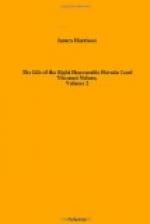Thus determined, every exertion was used, though with little hope, to overtake them, if possible, on their return; and, on the 14th, at noon, the fleet had run a hundred and thirteen miles from the Island of Barbuda, and a hundred and thirty from St. John’s Bay, Antigua.
On the 18th, the Amazon communicated with a schooner; which had, on the 15th, at sunset, seen a fleet of twenty-two ships of war steering to the northward. On a computation formed from an examination of the schooner’s then latitude and longitude, it appeared that the French fleet were, the night before, about eighty-seven leagues distant. His lordship, next day, forwarded the Martin to Gibraltar, and the Decade to Lisbon, with information of the enemy’s return to Europe. At midnight, on the 21st, Lord Nelson saw three planks floating; which, he thought, came from the French ships: and, on the 23d, at dusk, a piece of a large ship’s topmast had also passed by the Victory, but was not observed till too late to be picked up. Sir John Laforey, next morning, informed his lordship that, three days after they left Antigua, he had passed close by a bucket; which he supposed, by the make and wooden handle, to be French: also, a large chest, painted red.
From this period, till the 5th of June, the wind proved tolerably favourable; but they now, to use his lordship’s expression, barely “crawled” about thirty miles every twenty-four hours. “My only hope is,” writes the hero, “that the enemy’s fleet are near us, and in the same situation.” By a Spanish log and chart, taken out of a small bark from La Guira to Cadiz, his lordship found that the combined fleets went in sight of Cape Blanco, and passed over to the Salvages.




